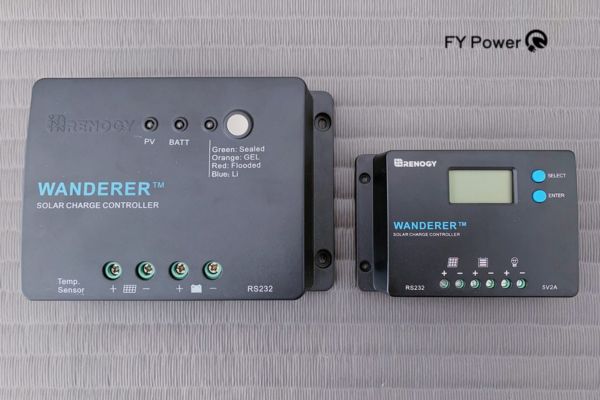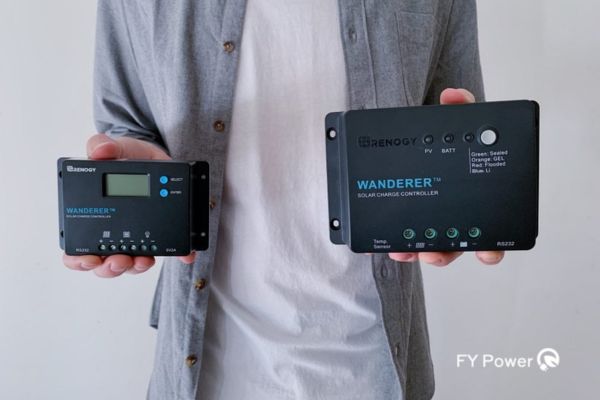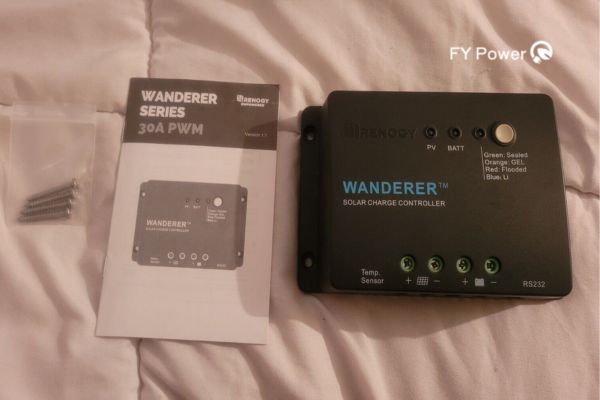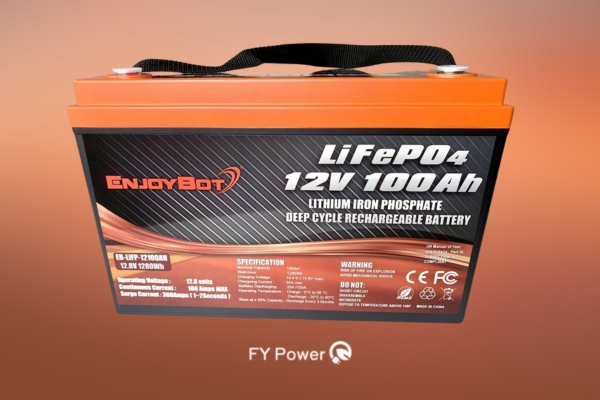Embarking on the eco-friendly journey of solar power management takes a reliable mate, and the Renogy Wanderer promises to be just that trusty companion. With its compact design and smart technology, it’s built to optimize your solar energy system effectively.
Have you wondered how this little device can safeguard your green investment and ease your power management woes? I’m here to shed some light on that, as we take a deep dive into what makes the Renogy Wanderer stand out in a crowded market of solar charge controllers.
The Renogy Wanderer is renowned for maximizing battery life and ensuring efficient power consumption with its intelligent charge controller capabilities. Whether you are an eco-conscious homeowner or a passionate road-tripper with a love for RV life, the 30A variant stands as an affordable option without skimping on quality.
Its easy installation, and compatibility with different battery types, including lithium batteries—paired with essential protection features against overcharging and over-discharging—makes it indispensable for those harnessing the sun’s free energy.
Here’s What You Can Expect:
- A straightforward high-level overview of the Renogy Wanderer’s value
- Essential insights into operational features for both nifty tech users and beginners
- An honest look at merits versus drawbacks straight from testing insights
- Clear guidance on whether this innovative product matches your specific needs
Understanding the Renogy Wanderer’s Role in Solar Power Management
When you hear about solar power, you often think of the sun, panels, and the energy you can get for free. But what many folks don’t know is how important it is to control that power. That’s where something like the Renogy Wanderer comes in – it’s a kind of traffic cop for solar energy.

The Basics of Charge Controllers
A charge controller is like a guard. It watches over your solar batteries to make sure they don’t get too much or too little power from your solar panels. Too much can hurt the batteries—it’s like overeating—and too little is just not helpful.
The Renogy Wanderer uses PWM technology—which stands for Pulse Width Modulation. Think about it as dimming a light. With PWM, the Renogy Wanderer turns down the power coming from your panels just right so that your batteries charge up safely and well. This tech is great because it makes things run smoothly and means longer life for your batteries.
Why Choose a Renogy Product?
But why go for Renogy products, especially this one? Well, Renogy has got a name in this world—people know their stuff works well and lasts long.
First off, trust—you trust them to keep things running without any hiccups.
Secondly, quality—their gear doesn’t break down on you when you need it most.
And lastly, support—if something does go wrong or if you’re just stuck, they’ve got people who’ll help you understand what’s what.
With the Renogy Wanderer, especially when talking about its reliability and how well it keeps an eye on things, going with them feels pretty wise.
Also Read: Can you run a generator in the rain?
Delving into The Features and Specifications
When looking at something like the Renogy Wanderer, you want to know what it’s made of and what it can do. I’ve put together a table that’s easy to understand, so you can see all the important stuff about this solar charge controller in one place.
| Feature | Specification |
|---|---|
| Material | Lithium |
| Nominal Voltage | 12 VDC |
| Rated Charge Current | 30A |
| Max. PV Input Voltage | 25 VDC |
| Max. PV Input Power | 400W |
| Dimensions | 6.45 x 4.31 x 1.76 inches |
| Weight | 0.65 lbs |
| Waterproof grade | Not specified |
| Mounting Options | Surface mount |
| Available sizes | 10A Positive Ground, 10A, 30A PWM Li |
Detailed Look at Renogy Wanderer 30A
When I’m thinking about power, the Renogy Wanderer 30A comes to mind. It’s a robust solar charge controller designed for a smooth energy flow from solar panels to my battery. Let me break down what makes this piece of gear tick.

- Brand and Material: The Renogy Wanderer is a name trusted by many for good reason. The company knows its stuff when it comes to solar tech, and they’ve uses quality lithium material for this charge controller.
- Nominal Voltage: This unit operates on a nominal system voltage of 12 VDC which is ideal for many off-grid applications.
- Rated Charge Current: A rated charge current of 30A means it’s ready to handle significant power flow without breaking a sweat.
- PV Input specifics: With a Max PV Input Voltage of 25 VDC, and Max PV Input Power of 400W, it’s quite clear that this device can take up decently sized solar arrays.
- Size Matters: At dimensions of just 6.45 x 4.31 x 1.76 inches and weighing only about .65 lbs, the Renogy Wanderer doesn’t eat up valuable space.
- Mounting Flexibility: Surface mount options give me the freedom to install it wherever I see fit.
By integrating PWM (Pulse Width Modulation) technology, the Wanderer ensures efficient charging by maintaining the battery’s life cycle and preventing overcharging.
Diving Into The Affordable Side With Renogy Wanderer 10A
Budget constraints shouldn’t mean sacrificing quality when seeking sustainable energy solutions. Enter the Renogy Wanderer 10A – it’s like the younger sibling of the 30A model but still packs a good punch.
Here are some highlights:
- Rated Charge Current stands at an ample capacity of 10A – perfect for smaller setups or if I’m just starting out with solar.
- Nominal Voltage remains at that sweet spot of 12 VDC – making compatibility worries take a back seat.
- It also sports surface mounting abilities which means my walls aren’t going to complain about odd fixtures sticking out.
Whether working with limited roof space or aiming for something more portable, this little guy fits into less vast solar dreams just right and keeps essential devices powered up.
Also Read: DIY Solar Lighting Magic: Simple Steps to Brighten Nights
Setting Up Your System with Ease
Installing your new Renogy Wanderer doesn’t need an engineering degree; with some basic tools and guidance, you’re golden!
Installation Guide for Your New Renogy Wanderer
First thing’s first: Safety! Be sure all related systems are off before getting started:
- Locating an appropriate spot on your wall – one that’s free from direct sunlight or moisture is ideal since we want our control center to feel comfortable too!
- Drill mounting holes basing them on dimensions provided by Renogy. Follow their lead; they’ve done this plenty!
- Securely attach your controller using screws – no loose fittings here; we want sturdy dependability!
- Next up is connecting battery cables—make sure you’ve got positive to positive (red), and negative to negative (black). Keep these connections snugger than best friends in winter!
- Now let’s connect those solar panel cables — same deal as before but you’ll be looking skyward instead as you secure these cables in place.
- Finally, switch everything on in sequence – battery first then panels – bask in that small victory dance because now we’re harvesting sunbeams!
Navigating Operation and Performance
When I use a solar charge controller like the Renogy Wanderer, I want to know how it works every day. Today, I’m going to take a close look at the 30A model and then share what it’s like using the smaller 10A version.

Up Close With Operative Nuances of Renogy Wanderer 30A
The Renogy Wanderer 30A stands out for its easy operation. Daily, I find it to be very reliable. It connects easily with my solar panels and battery setup. There is a handy LCD screen that shows important info like battery status and charge levels; this helps me keep track of everything without hassle.
One feature that catches my attention is the four-stage charging process: bulk, boost, float, and equalization. These stages ensure that my battery charges safely and lasts longer. The controller also protects against overcharging or discharging too much which can hurt the battery life.
Here are some details:
- LCD Display: Let me see what’s happening at a glance.
- Multiple Protection Features: Keeps batteries from getting damaged by things like overcharging.
- Four-Stage Charging: Helps in maintaining long-term battery health.
Sometimes when I have lots of devices using power, this controller manages it all without skipping a beat. It can handle up to 400 watts coming from the solar panels which means more power for more stuff!
Operating Insights on The Compact Technology Wanderer 10A
Now let’s talk about the smaller sibling, the Renogy Wanderer 10A. This one is perfect if you’re not needing too much power or if you’re trying to save some money but still want quality.
The thing is small but punches above its weight. Operation-wise, this little gadget is super simple. There are fewer settings compared with the bigger model which means there’s less chance of getting mixed up with too many buttons or menus.
It shares many good things with its bigger brother:
- Easy Setup: Plug in your panels and batteries, and you’re good.
- Safety Protections: Just like the larger version, it keeps your battery safe from common problems like overcharging or excessive discharge.
Mostly everything runs smoothly – lights stay on and gadgets keep charging – even when clouds pass by thanks to clever adjustments made by the charge controller matter whether your solar setup is big or small, these guys make sure you’ve got power when you need it without being tough to use!
Also Read: BougeRV 30 Quart Fridge Review: Unbeatable Mobile Cooling
Pros And Cons of Renogy Wanderer
When I think about the Renogy Wanderer, I’ve got to be honest with you. This little device has its good sides and its not-so-good sides. I’m going to break it down for you, keeping it simple and straight to the point.
Pros:
- Easy Installation: You don’t need to be a tech wizard to set this thing up. It’s pretty straightforward and doesn’t take much time.
- Compatibility: The Renogy Wanderer works well with different battery types, including lithium, which is great because lithium batteries are getting more popular these days.
- Affordability: Compared to other solar charge controllers out there, this one won’t make your wallet cry.
- Portability: It’s light and not too bulky, so moving it around or fitting it into small spaces isn’t a big fuss.
Cons:
- Limited Features: It’s a basic controller without some of the fancy features that other models might have.
- Not Waterproof: This is something you should think about if your setup is exposed to the elements because this controller can’t take a swim.
- PWM Technology Limitations: The Pulse Width Modulation (PWM) technology is solid but doesn’t always charge as fast as the Maximum Power Point Tracking (MPPT) controllers.
- No Display: The Renogy Wanderer doesn’t come with a screen to show you what’s going on. If you like to have visual feedback directly from your device, this might be a drawback.
Recommendation – Who Should Buy It?
When I look at a product, I ask myself, “Who would get the most out of this?” For the Renogy Wanderer solar charge controller, there are a few types of people who should think about getting it. Let me tell you who they are and why it might be a good fit for them.
- Off-Grid Living Enthusiasts: If you’re someone who loves the idea of living off the land and being self-sustainable, this is for you. The Renogy Wanderer can help keep your batteries charged with solar power, making it essential for your off-grid energy system.
- RV Owners and Campers: Anyone with an RV or who goes camping often will know how important it is to have a reliable power source. The Renogy Wanderer can make sure your batteries stay full using the sun’s energy. This means you can keep your lights on and gadgets charged without hooking up to external power sources.
- Eco-Conscious Homeowners: If reducing your carbon footprint is important to you, then adding solar elements to your home can be a solid step forward. The Renogy Wanderer helps manage small-scale solar setups perfectly.
- Boat Owners: Boats need power too, especially when you’re far from shore. Like an RV owner or camper, if you own a boat, the Wanderer could be just what you need to manage that precious electricity drawn from solar panels.
- Budget-Minded DIYers: Setting up a solar system doesn’t have to break the bank. If you’re on a budget and handy with tools and tech, adding this affordable charge controller to your system is smart thinking.
The key things I’ve shared about who should buy the Renogy Wanderer aren’t complex ideas — they’re simple and straightforward so anyone can understand why this might—or might not—be what they’re looking for in their next piece of kit for harnessing the sun’s power efficiently and effectively!
Conclusion
When it comes down to managing solar power efficiently, the Renogy Wanderer steps up as a reliable companion. Whether I’m looking into the 30A or opt for the more budget-conscious 10A version, it’s clear that this solar charge controller doesn’t skimp on quality.
From easy installation to daily operation, it proves to be user-friendly even for those new to solar power setups. The detailed wanderer review reveals both its strengths and limitations transparently.

